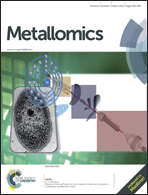Changes in copper concentrations affect the protein levels but not the mRNA levels of copper chaperones in human umbilical vein endothelial cells
Abstract
Copper chaperones are critical regulators of intracellular copper metabolism and distribution. The present study was undertaken to investigate the effects of changes in copper concentrations on the abundance of copper chaperones. Human umbilical vein endothelial cells (HUVECs) were treated with siRNA targeting copper transporter 1 (CTR1) or tetraethylenepentamine (TEPA) to decrease, or with copper sulfide to increase, intracellular copper concentrations, assayed using an atomic absorption spectrophotometer. Western blot analyses showed that CTR1 silencing or TEPA treatment increased the protein levels of copper chaperone ATOX1 and copper chaperone for superoxide dismutase 1 (CCS-1), but decreased copper chaperone for cytochrome c oxidase (COX17). In contrast, copper supplementation decreased the protein levels of ATOX1 and CCS-1 and increased COX17. Real-time RT-PCR analyses found no difference in the mRNA levels of the copper chaperones examined under the conditions defined above. This study thus demonstrated that changes in copper concentrations alter the protein levels, but not the mRNA levels, of copper chaperones, suggesting a role of copper in the post-translational modification of these proteins.


 Please wait while we load your content...
Please wait while we load your content...